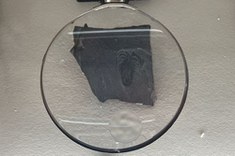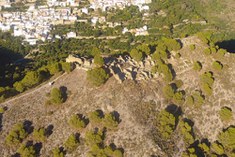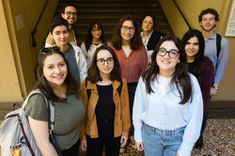Italy's first herd of dinosaurs
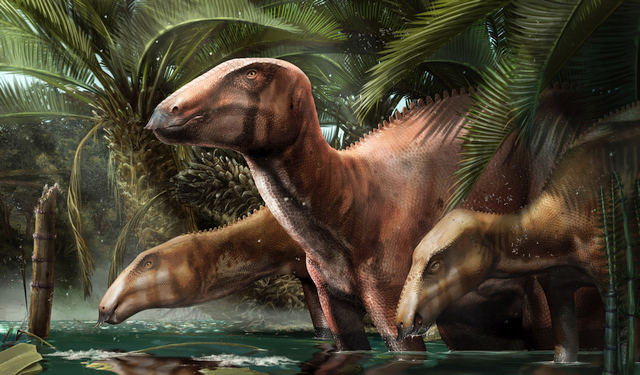
An adult and two juvenile individuals of the dinosaur Tethyshadros insularis showing the different appearances exhibited by immature and mature specimens in the ancient environment of Villaggio del Pescatore, the first locality in Italy preserving many dinosaur individuals of the same species (Image: Davide Bonadonna)
There is a herd of dinosaurs in Italy. Several perfectly preserved skeletons have been found in Villaggio del Pescatore (Italy), a town within Duino-Aurisina City Council a few kilometres from Trieste. The discovery was announced by an international research team coordinated by scholars from the University of Bologna in an article published in the Nature journal Scientific Reports.
These exceptional unearthed skeletons belong to the species Tethyshadros insularis. There are at least seven, possibly eleven, specimens including a newly discovered dinosaur that has been nicknamed "Bruno" and is the largest dinosaur ever found in Italy.
Fish, crocodiles, marine reptiles, and small crustaceans have also been found on this site and now provide a clear insight into this ancient and unique ecosystem. The archaeological finds unearthed at Villaggio del Pescatore were granted in storage by the Italian Ministry of Culture to Trieste Civic Museum of Natural History where they are now on public display for everyone to admire.
“For the first time in Italy we have a dinosaur fossil site containing many remains of these animals together with the other living beings that shared that remote lost world,” says Federico Fanti, coordinator of the study as well as professor at the Department of Biological, Geological and Environmental Sciences of the University of Bologna. “This is a unique site where we have the possibility to unearth many dinosaur skeletons, each one more extraordinary than the last, and we are seizing this opportunity. Moreover, this is the first time we know exactly where to keep digging.”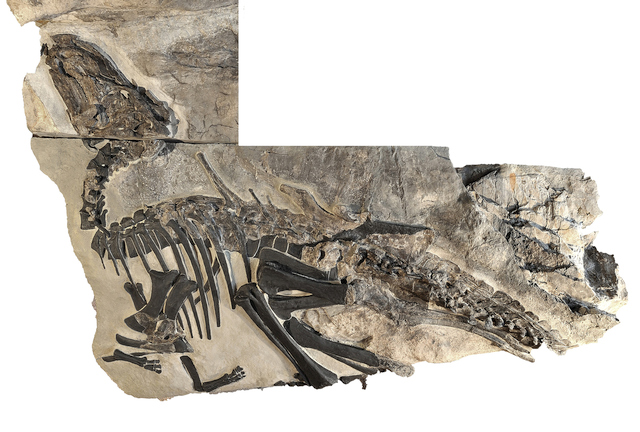
The skeleton of Bruno, an adult individual of the dinosaur Tethyshadros insularis described in this new study (Photo: P. Ferrieri, courtesy of Soprintendenza Archeologia, belle arti e paesaggio del Friuli-Venezia Giulia)
DINOSAURS OF THE MEDITERRANEAN
Prior to today, only one other specimen had been discovered in Villaggio del Pescatore in the early 1990s: a small dinosaur nicknamed "Antonio" whose small size had led to the assumption that Tethyshadros insularis might be a “dwarf” species. Bruno with its larger body and more massive build now proves that Antonio simply was a young specimen. In fact, researchers performed a bone structure analysis with the use of a microscope and showed that Bruno had not yet stopped growing at the time of his death.
Moreover, new geological data from the analysis of the fossil site have helped reassess the age of these dinosaurs which allegedly date back 80 million years and are therefore 10 million years older than previously assumed.
“These newly discovered skeletons allow us to better understand the evolutionary history of the hadrosauriform: a group of duck-billed dinosaurs that includes Bruno and Antonio among their specimens,” explains Alfio Alessandro Chiarenza, first author of the study from the University of Vigo (Spain). “We have found how these dinosaurs arrived in the heart of the Mediterranean during the Cretaceous period, about 80 million years ago. We used to think of a world made up only of small tropical islands that were not particularly suitable for large dinosaurs. New data now show that large landmasses connected to Asia and Western Europe allowed some animals to survive, as happened to those of Villaggio del Pescatore, and, more importantly, to fossilize eventually getting well-preserved to the present day.”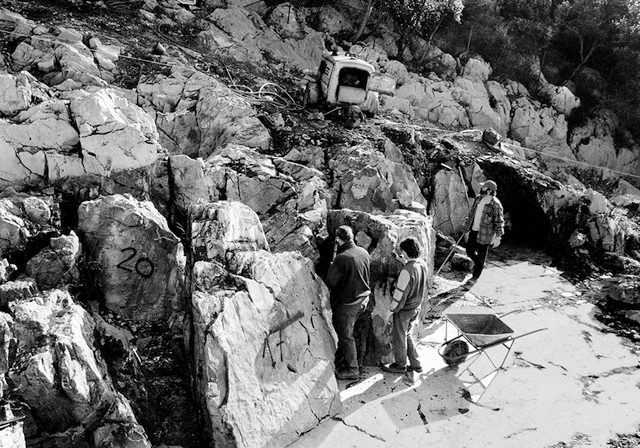
The palaeontological site of Villaggio del Pescatore, with people from ZOIC working to extract the fossils from this astounding dinosaur trove (Photo: ZOIC s.r.l.)
FROM “ANTONIO” TO “BRUNO”
At the time of the dinosaurs, between 230 and 66 million years ago, the area now occupied by the Mediterranean Sea would have been difficult to draw on a map. It consisted of several small islands far from the great European, African, and Asian continental masses. It was therefore a particularly unsuitable place for large herds of dinosaurs. It is no coincidence that for a long time geologists considered the Villaggio del Pescatore area to be an island located in the middle of an ancient ocean called Tethys.
The Villaggio del Pescatore site first made headlines in the late 1980s when two geology enthusiasts, Alceo Tarlao and Giorgio Rimoli, came across unexpected fossilised remains of bones. A few years later, in 1994, a geology student, Tiziana Brazzatti, was inspecting the archaeological pit when she discovered the site's first full skeleton.
The research activities following the discovery quickly identified the bones. Nonetheless, the hunt for the dinosaur proved particularly difficult and researchers had to use diamond blades, excavators and bulldozers to extract the large blocks of hard limestone preserving the remains. Afterwards, problems kept coming up as the large rocks had to be given long acid baths to reveal the fossilised remains. It was only at this point that Antonio, a perfectly preserved duck-billed dinosaur and almost five metres long, finally appeared. It was the first specimen of Tethyshadros insularis.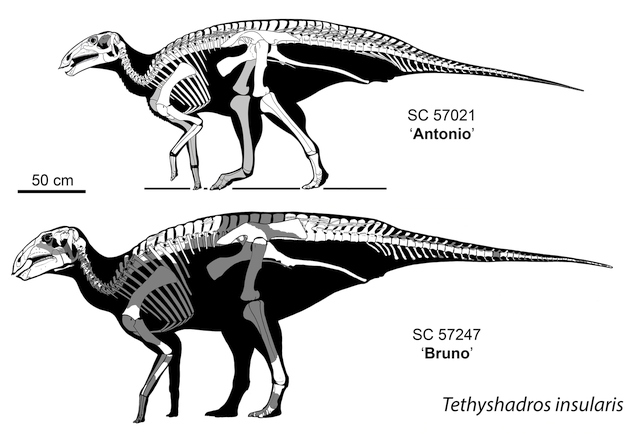
Skeletal reconstructions of the two individuals of Tethyshadros insularis, with the immature specimen nicknamed "Antonio" (above) and the mature, newly described skeleton of "Bruno" below
AN ADULT DINOSAUR
Its initial dating to 70 million years ago, its relatively small size and the fact that Villaggio del Pescatore was an island in the middle of the ocean led to the assumption that Antonio belonged to a “dwarf” species who adapted to survive with the limited resources of such small islands. However, the other newly discovered specimens, in particular Bruno with its larger body, has led scholars to reconsider this hypothesis.
“Bruno belongs to the same species as Antonio, even though it is larger and more massive. This can be explained simply: they are not the same age,” explains Fanti. “Bruno is larger and older than Antonio and as it happens in every species we know today, it looks different precisely because of its age. These two specimens show us something that we rarely see in dinosaurs: how they changed as they grew.”
The new dating places these dinosaurs at 80 million years ago and suggests that the Villaggio del Pescatore area was a land overlooking the Tethys Ocean and connected to Western Europe and Asia and not an island. Indeed, they were two large landmasses that represented migration routes for large land animals such as dinosaurs.
“The Villaggio del Pescatore site represents a unique opportunity to make dinosaurs known to the Italian general public and to teach how palaeontology and geology are part of our cultural heritage,” concludes Fanti. “This site represents both a finish line and a starting point for understanding the history of dinosaurs and of the entire Mediterranean area of millions of years ago.”
The skull of "Bruno", the newly described skeleton of the dinosaur Tethyshadros insularis (Photo: A. Giamborino, courtesy of Soprintendenza Archeologia, belle arti e paesaggio del Friuli-Venezia Giulia)
THE AUTHORS OF THE STUDY
The study was published in the journal Scientific Reports under the title “An Italian dinosaur Lagerstätte reveals the time and mode of hadrosauriform body size evolution”. Federico Fanti and Marco Muscioni from the Department of Biological, Geological and Environmental Sciences were the scholars representing the University of Bologna. Other participants included scholars from the University of Vigo (Spain), the Field Museum of Natural History in Chicago (USA), the University of Trieste (Italy), the University of Toronto (Canada) and the University of Alcalá (Spain).


